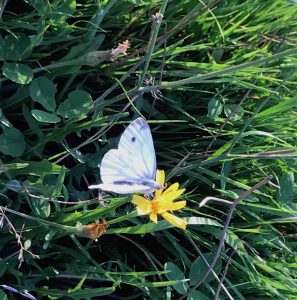I was sitting by a river, enjoying both the warmth of the sun and good conversation, when I noticed a butterfly flitting about. They are always so delicate, catching the breeze and landing briefly to check out a flower for food before moving to the next and the next. One can well understand why butterfly nets, used by people looking to capture these lovely creatures, are so large. They can be very ‘flighty’. It was with great care that I followed this butterfly, for a while, before it settled long enough for me to take this picture.

Having captured my photograph, conversation resumed, and the sun enjoyed, before it was time to carry on our way.
The butterfly reminded me of a story, which I shared as we walked. It is about a boy who sees a monk holding something carefully, attached to a twig. Intrigued what this was, he asked the monk. The reply came that it was a chrysalis, from which a beautiful butterfly would emerge.
The boy asked if he could have the chrysalis and see the butterfly emerge. The monk agreed but only after he stressed that the boy must do nothing to help the butterfly when it started to appear, even if it seemed to struggle. The boy agreed, and took great interest keeping a close eye on the chrysalis, not to miss the time when the butterfly surfaced.
When the butterfly started to emerge, the boy was surprised as it was so slow, and the butterfly was also quite wet. First came out one small part, then slowly another part. The butterfly seemed to be really struggling, and the boy was concerned by the struggle it was having. It continued to struggle for a long time; the boy thought it was not going to manage to break free and would die. So, he made a cut in the cocoon to help; this helped the insect to get out of the cocoon much more easily, but its wings were very wet and it was unable to fly, and fell to the ground, eventually dying.
He was upset, and when next he saw the monk, he told him the butterfly didn’t live. The monk asked the boy whether he had done anything to help the butterfly. The boy rather shyly admitted that he had helped; only because it was struggling so much, and it was painful for him to watch, when he knew he could help.
The monk kindly explained to the boy that the very struggle of having to squeeze out of the cocoon helped to force the fluid from the wings into the body, and off the wings, allowing the butterfly to fully open its wings when it emerges into the open. It would then rest, while the wings fully dried, before it could fly. From the struggle the butterfly gains strength, emerges fully formed, the wings less wet and heavy, so it can quickly dry, and then be able to fly.
Sometimes we see the young struggle, and it is sometimes painful to watch too – yet when we step in and think we are helping, are we helping them strengthen their own wings?
In some parts of the world the struggle is tough – even for survival.
Yet for others there is so much available, so much expected, so much easily given, so little ‘struggle’, so little real appreciation. How strong are their wings?
A chance encounter with the butterfly certainly reminded me of a valuable story; a valuable lesson; even as we grow older, we can grow stronger by embracing the struggle. It certainly makes tiredness through effort satisfying; the prize all the more pleasurable to win; the reward well earnt.
The questions I asked myself:
- ‘When do I help too much, when I should let the other person learn more and grow stronger through their own struggle?’
- ‘When could I ‘struggle’ more and become stronger, more appreciative, develop greater/deeper learning?’
Hmm…
My best wishes,
Peter